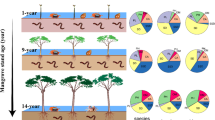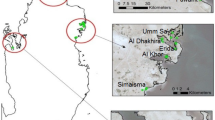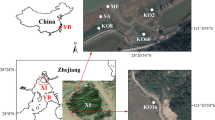Abstract
The community structure and diet of benthic macrofauna in a Spartina alterniflora wetland and restored native Kandelia obovata mangrove forests of different ages were compared in Zhangjiangkou estuary, China. The biodiversity and total density of benthic macrofauna did not change after the restoration of Spartina wetlands with native mangrove species. However, the total biomass decreased significantly approximately half a year after physical treatments. This decrease in total biomass resulted from a change in the dominant gastropod from the larger Cerithidea djariensis to the smaller Assimine abrevicula. Gastropod and crab species in the Spartina wetland derived more than 80 % of their organic carbon from Spartina. Preliminary physical treatment and plantings of K. obovata did not change the diets of benthic macrofauna during year one of the restoration, but δ13C values in gastropod and crab species collected in both 10- and 40-year K. obovata forests were more depleted than those measured in the Spartina wetland, indicating a change in the diet of benthic macrofauna from homogenous to heterogeneous. These results suggest that biological replacement using native mangrove species can not only successfully control the spread of invasive Spartina, but also restore the diverse food web typical of a mature mangrove ecosystem.




Similar content being viewed by others
References
Alongi DM (1988) Bacterial productivity and microbial biomass in tropical mangrove sediments. Microbial Ecology 15:59–79
Alongi DM (2002) Present state and future of the world’s mangrove forests. Environmental Conservation 29:331–349
An S, Gu B, Zhou C, Wang Z, Deng Z, Zhi Y, Li H, Chen L, Yu D, Liu Y (2007) Spartina invasion in China: implications for invasive species management and future research. Weed Research 47:183–191
Bonilla-Warford CM, Zedler JB (2002) Potential for using native plant species in stormwater wetlands. Environmental Management 29:385–394
Bosire J, Dahdouh-Guebas F, Walton M, Crona B, Lewis R, Field C, Kairo J, Koedam N (2008) Functionality of restored mangroves: a review. Aquatic Botany 89:251–259
Bouillon S, Connolly RM, Lee SY (2008) Organic matter exchange and cycling in mangrove ecosystems: recent insights from stable isotope studies. Journal of Sea Research 59:44–58
Brusati ED, Grosholz ED (2009) Does invasion of hybrid cordgrass change estuarine food webs? Biological Invasions 11:917–926
Chen H (2013) Carbon sequestration, litter decomposition and consumption in two subtropical mangrove ecosystems of China (in Chinese with English abstract). Ph D thesis, Xiamen University, Xiamen
Chen G, Ye Y (2011) Restoration of Aegiceras corniculatum mangroves in Jiulongjiang Estuary changed macro-benthic faunal community. Ecological Engineering 37:224–228
Chen GC, Ye Y, Lu CY (2007) Changes of macro-benthic faunal community with stand age of rehabilitated Kandelia candel mangrove in Jiulongjiang Estuary, China. Ecological Engineering 31:215–224
Chen L, Wang W, Zhang Y, Lin G (2009a) Recent progresses in mangrove conservation, restoration and research in China. Journal of Plant Ecology 2:45–54
Chen Z, Guo L, Jin B, Wu J, Zheng G (2009b) Effect of the exotic plant Spartina alterniflora on macrobenthos communities in salt marshes of the Yangtze River Estuary, China. Estuarine, Coastal and Shelf Science 82:265–272
Cui B, He Q, An Y (2011) Spartina alterniflora invasions and effects on crab communities in a western Pacific estuary. Ecological Engineering 37:1920–1924
Daehler CC, Strong DR (1996) Status, prediction and prevention of introduced cordgrass Spartina spp. invasions in Pacific estuaries, USA. Biological Conservation 78:51–58
Dibble KL, Meyerson LA (2014) The effects of plant invasion and ecosystem restoration on energy flow through salt marsh food webs. Estuaries and Coasts 37:339–353
Dibble KL, Pooler PS, Meyerson LA (2013) Impacts of plant invasions can be reversed through restoration: a regional meta-analysis of faunal communities. Biological Invasions 15:1725–1737
Frid C, Chandrasekara W, Davey P (1999) The restoration of mud flats invaded by common cord-grass (Spartina anglica, CE Hubbard) using mechanical disturbance and its effects on the macrobenthic fauna. Aquatic Conservation: Marine and Freshwater Ecosystems 9:47–61
Gratton C, Denno RF (2006) Arthropod food web restoration following removal of an invasive wetland plant. Ecological Applications 16:622–631
Grosholz E (2002) Ecological and evolutionary consequences of coastal invasions. Trends in Ecology & Evolution 17:22–27
Hedge P, Kriwoken LK, Patten K (2003) A review of Spartina management in Washington State, US. Journal of Aquatic Plant Management 41:82–90
Howe ER, Simenstad CA (2011) Isotopic determination of food web origins in restoring and ancient estuarine wetlands of the San Francisco Bay and Delta. Estuaries and Coasts 34:597–617
Kon K, Kurokura H, Tongnunui P (2010) Effects of the physical structure of mangrove vegetation on a benthic faunal community. Journal of Experimental Marine Biology and Ecology 383:171–180
Kon K, Kurokura H, Tongnunui P (2011) Influence of a microhabitat on the structuring of the benthic macrofaunal community in a mangrove forest. Hydrobiologia 671:205–216
Kristensen E, Bouillon S, Dittmar T, Marchand C (2008) Organic carbon dynamics in mangrove ecosystems: a review. Aquatic Botany 89:201–219
Kruitwagen G, Nagelkerken I, Lugendo BR, Mgaya YD, Bonga SEW (2010) Importance of different carbon sources for macroinvertebrates and fishes of an interlinked mangrove-mudflat ecosystem (Tanzania). Estuarine, Coastal and Shelf Science 88:464–472
Lee SY (1998) Ecological role of grapsid crabs in mangrove ecosystems: a review. Marine and Freshwater Research 49:335–343
Lee SY (2008) Mangrove macrobenthos: assemblages, services, and linkages. Journal of Sea Research 59:16–29
Levin LA, Talley TS, Hewitt J (1998) Macrobenthos of Spartina foliosa (Pacific cordgrass) salt marshes in southern California: community structure and comparison to a Pacific mudflat and a Spartina alterniflora (Atlantic smooth cordgrass) marsh. Estuaries and Coasts 21:129–144
Levin LA, Neira C, Grosholz ED (2006) Invasive cordgrass modifies wetland trophic function. Ecology 87:419–432
Li B, Liao CZ, Zhang XD, Chen HL, Wang Q, Chen ZY, Gan XJ, Wu JH, Zhao B, Ma ZJ, Cheng XL, Jiang LF, Chen JK (2009) Spartina alterniflora invasions in the Yangtze River estuary, China: an overview of current status and ecosystem effects. Ecological Engineering 35:511–520
Liao C, Luo Y, Jiang L, Zhou X, Wu X, Fang C, Chen J, Li B (2007) Invasion of Spartina alterniflora enhanced ecosystem carbon and nitrogen stocks in the Yangtze Estuary, China. Ecosystems 10:1351–1361
Mazumder D, Saintilan N (2010) Mangrove leaves are not an important source of dietary carbon and nitrogen for crabs in temperate Australian Mangroves. Wetlands 30:375–380
McCutchan JH, Lewis WM, Kendall C, McGrath CC (2003) Variation in trophic shift for stable isotope ratios of carbon, nitrogen, and sulfur. Oikos 102:378–390
McKee KL, Rooth JE, Feller IC (2007) Mangrove recruitment after forest disturbance is facilitated by herbaceous species in the Caribbean. Ecological Applications 17:1678–1693
Moreno-Mateos D, Power ME, Comín FA, Yockteng R (2012) Structural and functional loss in restored wetland ecosystems. PLoS Biology 10:e1001247
Nagelkerken I, Blaber S, Bouillon S, Green P, Haywood M, Kirton L, Meynecke J-O, Pawlik J, Penrose H, Sasekumar A (2008) The habitat function of mangroves for terrestrial and marine fauna: a review. Aquatic Botany 89:155–185
Neira C, Levin LA, Grosholz ED (2005) Benthic macrofaunal communities of three sites in San Francisco Bay invaded by hybrid Spartina, with comparison to uninvaded habitats. Marine Ecology Progress Series 292:111–126
Neira C, Grosholz ED, Levin LA, Blake R (2006) Mechanisms generating modification of benthos following tidal flat invasion by a Spartina hybrid. Ecological Applications 16:1391–1404
Palmer MA, Ambrose RF, Poff NL (1997) Ecological theory and community restoration ecology. Restoration Ecology 5:291–300
Qin H, Chu T, Xu W, Lei G, Chen Z, Quan W, Chen J, Wu J (2010) Effects of invasive cordgrass on crab distributions and diets in a Chinese salt marsh. Marine Ecology Progress Series 415:177–187
Quan W, Fu C, Jin B, Luo Y, Li B, Chen J, Wu J (2007) Tidal marshes as energy sources for commercially important nektonic organisms: stable isotope analysis. Marine Ecology Progress Series 352:89–99
Roberts PD, Pullin AS (2008) The effectiveness of management interventions for the control of Spartina species: a systematic review and meta‐analysis. Aquatic Conservation: Marine and Freshwater Ecosystems 18:592–618
Simberloff D (2005) Non-native species do threaten the natural environment! Journal of Agricultural and Environmental Ethics 18:595–607
Tang GL, Shen LH, Weng WH, Zhang JE, Liao BW, Liu JL, Teng XS (2007) Efects of Using Sonneratia apetala to Control the Growth of Spartina alterniflora Loisel (In Chinese with English abstract). Journal of South China Xgricultural University 28:10–13
Tue NT, Hamaoka H, Sogabe A, Quy TD, Nhuan MT, Omori K (2012) Food sources of macro-invertebrates in an important mangrove ecosystem of Vietnam determined by dual stable isotope signatures. Journal of Sea Research 72:14–21
Vitousek PM, D’Antonio CM, Loope LL, Westbrooks R (1996) Biological invasions as global environmental change. American Scientist 84:468–478
Wang RZ, Zhang LQ (2009) Effect of managed wa terlogg ing to control Spartina alterniflora on macrobenthic communities (In Chinese with English abstract). Acta Ecologica Sinica 29:2639–2645
Werry J, Lee S (2005) Grapsid crabs mediate link between mangrove litter production and estuarine planktonic food chains. Marine Ecology Progress Series 293:165–176
Zhang Y, Huang G, Wang W, Chen L, Lin G (2012) Interactions between mangroves and exotic Spartina in an anthropogenically disturbed estuary in southern China. Ecology 93:588–597
Zhou HX, Liu J, Qin P (2009) Impacts of an alien species (Spartina alterniflora) on the macrobenthos community of Jiangsu coastal inter-tidal ecosystem. Ecological Engineering 35:521–528
Zuo P, Zhao S, Liu CA, Wang C, Liang Y (2012) Distribution of Spartina spp. along China’s coast. Ecological Engineering 40:160–166
Acknowledgments
This study was supported financially by a grant from the National Natural Science Foundation of China (30930017) and by Ocean Public Fund Research Projects (201305021, 200905009). We thank Zhiyong Pang and Yuan Ke for stable isotope analyses and Yun Li for stable isotope sample preparations. We thank Jonathon S. Wright for improving the English of this manuscript and two reviewers for improving the manuscript. We are also grateful to the staff at Zhangjiang Estuary mangrove National Nature Reserve for the access to study sites and for providing logistic supports during our field studies.
Author information
Authors and Affiliations
Corresponding author
Rights and permissions
About this article
Cite this article
Feng, J., Guo, J., Huang, Q. et al. Changes in the Community Structure and Diet of Benthic Macrofauna in Invasive Spartina alterniflora Wetlands Following Restoration with Native Mangroves. Wetlands 34, 673–683 (2014). https://doi.org/10.1007/s13157-014-0533-2
Received:
Accepted:
Published:
Issue Date:
DOI: https://doi.org/10.1007/s13157-014-0533-2




